James Harden, 6-5, Sophomore, Shooting Guard, Arizona State
21.3 points, 5.5 rebounds, 4.2 assists, 3.4 turnovers, 1.7 steals, 53% FG, 75% FT, 37% 3P
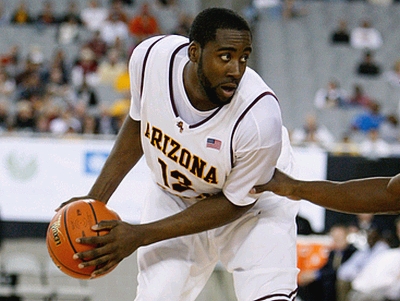
Taking in two games in person here in Tempe gave us an excellent opportunity to evaluate the progress of James Harden, clearly one of the top prospects in this years draft. Hes one of the more unique players youll find this year, and opinions about him are bound to vary widely.
The first thing that stands out about Harden is the fact that he is likely to be considered a below average athlete for the NBA level. His first step and pure explosiveness are nothing to write home about, meaning he has to find other ways to make his presence felt.
Harden plays a European style of basketball, making simple plays on every possession. Hes the consummate team player, showing extreme patience and never looking in a rush. He has a great assortment of hesitation moves and change of pace dribbles, often getting by players with a series of crafty maneuvers rather than with a pure first step. His physical attributes obviously arent ideal, but he knows how to make the most of them, thanks to his terrific basketball IQ.
Productivity wise, Harden has obviously elevated his game to being one of the top players in the NCAA this season. He is a terrific scorer, currently ranking as the 5th best in college basketball (per-40 minutes pace adjusted), despite the fact that every defense he faces is geared to stop him. He gets to the free throw line like an absolute machine regardless, ranking 8th in free throw attempts amongst all draft prospects.
Although hes one of the premier scorers in college basketball, Harden is an incredibly willing passer, displaying absolutely terrific court vision, particularly in his ability to drop off passes for easy finishes in the post, or finding the open man spotting up on the perimeter. Similar to Manu Ginobili, Harden is a clear-cut lefty who is much better going to his strong hand. The defense knows he wants to go in that direction, but is often unable to get him to do so, as he picks his spots so well.
Hardens shooting stroke is fairly peculiar, as he shoots a solid percentage from beyond the arc, but is mostly limited to flat-footed attempts. He struggles big time when trying to pull up off the dribble, seeing his percentages drop from 43 to 24 percent on non catch and shoot situations. He still makes a good amount of 3-point shots each game, on a solid 38% clip. The fact that he gets such little elevation on his jumper, cannot shoot off screens, and possesses very little in the ways of a mid-range game is somewhat of a concern at the moment, and something he definitely needs to work on in the NBA.
Defensively, Harden is very effective, as he plays a very smart, pesky, fundamental brand of defense, showing great timing and a real knack for making big plays. He comes up with plenty of blocks and steals, and is an excellent rebounder as well at his position. The fact that he possesses average size and lateral quickness might make it tough for him to defend the truly elite shooting guards in the NBA, but hes such a smart player that you really dont want to rule him out.
All in all, Harden is bound to make some NBA team very happy with the variety of skills he brings to the table, even if he might not project as a franchise-level talent and go-to guy right off the bat. While his upside might not be that of a superstar, he looks very likely to achieve his potential, making him a pretty safe pick. Whether hes worthy or not of being the top-3 or 5 pick hes currently projected as will likely depend heavily on the other prospects available, but from what we can tell now, he has a strong case to be considered the next best player after Blake Griffin is off the board.
The first thing that stands out about Harden is the fact that he is likely to be considered a below average athlete for the NBA level. His first step and pure explosiveness are nothing to write home about, meaning he has to find other ways to make his presence felt.
Harden plays a European style of basketball, making simple plays on every possession. Hes the consummate team player, showing extreme patience and never looking in a rush. He has a great assortment of hesitation moves and change of pace dribbles, often getting by players with a series of crafty maneuvers rather than with a pure first step. His physical attributes obviously arent ideal, but he knows how to make the most of them, thanks to his terrific basketball IQ.
Productivity wise, Harden has obviously elevated his game to being one of the top players in the NCAA this season. He is a terrific scorer, currently ranking as the 5th best in college basketball (per-40 minutes pace adjusted), despite the fact that every defense he faces is geared to stop him. He gets to the free throw line like an absolute machine regardless, ranking 8th in free throw attempts amongst all draft prospects.
Although hes one of the premier scorers in college basketball, Harden is an incredibly willing passer, displaying absolutely terrific court vision, particularly in his ability to drop off passes for easy finishes in the post, or finding the open man spotting up on the perimeter. Similar to Manu Ginobili, Harden is a clear-cut lefty who is much better going to his strong hand. The defense knows he wants to go in that direction, but is often unable to get him to do so, as he picks his spots so well.
Hardens shooting stroke is fairly peculiar, as he shoots a solid percentage from beyond the arc, but is mostly limited to flat-footed attempts. He struggles big time when trying to pull up off the dribble, seeing his percentages drop from 43 to 24 percent on non catch and shoot situations. He still makes a good amount of 3-point shots each game, on a solid 38% clip. The fact that he gets such little elevation on his jumper, cannot shoot off screens, and possesses very little in the ways of a mid-range game is somewhat of a concern at the moment, and something he definitely needs to work on in the NBA.
Defensively, Harden is very effective, as he plays a very smart, pesky, fundamental brand of defense, showing great timing and a real knack for making big plays. He comes up with plenty of blocks and steals, and is an excellent rebounder as well at his position. The fact that he possesses average size and lateral quickness might make it tough for him to defend the truly elite shooting guards in the NBA, but hes such a smart player that you really dont want to rule him out.
All in all, Harden is bound to make some NBA team very happy with the variety of skills he brings to the table, even if he might not project as a franchise-level talent and go-to guy right off the bat. While his upside might not be that of a superstar, he looks very likely to achieve his potential, making him a pretty safe pick. Whether hes worthy or not of being the top-3 or 5 pick hes currently projected as will likely depend heavily on the other prospects available, but from what we can tell now, he has a strong case to be considered the next best player after Blake Griffin is off the board.
Jrue Holiday, 6-4, Freshman, PG/SG, UCLA
9.4 points, 3.9 rebounds, 3.5 assists, 2.1 turnovers, 1.6 steals, 49% FG, 30% 3P, 73% FT
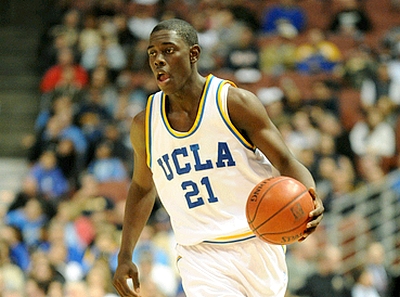
With our last update to his player profile coming just a month ago, there isnt a great deal of new information to report on Holiday at this time. His scoring rate has dropped a bit while his passing stats look much better, as its become increasingly clear that Holiday looks much more comfortable in a lead-guard role where he can handle the ball and make decisions as his teams playmaker. With Darren Collison being the senior and leader of this team and clearly one of the best point guards in the country, well probably have to wait until next year to see Holidays true potential at the collegiate level, if hes to return.
Even though hes become even less of a factor as a scorer recently, Holiday has done a terrific job showing his extremely high basketball IQ and outstanding passing skills. His court vision and creativity for making plays is very advanced for his age, and the patience and effectiveness he shows running the pick and roll definitely leaves a lot of optimism for the future, as he plays the game at a very unique pace. Holiday is obviously unselfish to a fault right now, sometimes looking too tentative and thinking too much, but as his comfort level grows within UCLAs offense, he should get even better.
The part of his game that looks the most concerning might be his perimeter stroke, which continues not to fall for him. Hes shooting just 30% from beyond the arc on nearly three attempts per game. Hes been equally streaky off the dribble as he is in catch and shoot situations, although he can obviously make both. Holiday is barely getting to the free throw line still, going seven games already this season without a single attempt, although he is hitting the ones he does take a little bit better now. With that said, he hits an outstanding 61% of his 2-point attempts, which ranks him tops amongst all point guards that category
Defensively, Holiday is still one of the best guards in college basketball, as he showed in the very difficult matchup he had with James Harden. He did a great job limiting him as much as possible off the dribble, moving his feet intelligently and showing great timing. Harden had a very good game in his own right, but the 8 turnovers he committed definitely stands out in the box score, and tells you quite a bit about the peskiness that Holiday brings to the table as a defender.
It will be very interesting to see if Holiday decides to test the NBA draft waters, as he doesnt look like the prototypical one and done candidate, and also probably hasnt produced the type of per-game stats to be considering such a move. Digging deeper in the numbers, though, you realize that his production as a freshman compares favorably with Russell Westbrooks numbers as a sophomore, which obviously didnt preclude him from being drafted fourth overall (and looking like an incredible talent early on). Holiday would probably benefit from playing another season of college basketball, and may want to leave much more of a legacy at UCLA than the fleeting glance weve gotten at him thus far, but he probably would be a lottery pick regardless if he decided to enter.
Even though hes become even less of a factor as a scorer recently, Holiday has done a terrific job showing his extremely high basketball IQ and outstanding passing skills. His court vision and creativity for making plays is very advanced for his age, and the patience and effectiveness he shows running the pick and roll definitely leaves a lot of optimism for the future, as he plays the game at a very unique pace. Holiday is obviously unselfish to a fault right now, sometimes looking too tentative and thinking too much, but as his comfort level grows within UCLAs offense, he should get even better.
The part of his game that looks the most concerning might be his perimeter stroke, which continues not to fall for him. Hes shooting just 30% from beyond the arc on nearly three attempts per game. Hes been equally streaky off the dribble as he is in catch and shoot situations, although he can obviously make both. Holiday is barely getting to the free throw line still, going seven games already this season without a single attempt, although he is hitting the ones he does take a little bit better now. With that said, he hits an outstanding 61% of his 2-point attempts, which ranks him tops amongst all point guards that category
Defensively, Holiday is still one of the best guards in college basketball, as he showed in the very difficult matchup he had with James Harden. He did a great job limiting him as much as possible off the dribble, moving his feet intelligently and showing great timing. Harden had a very good game in his own right, but the 8 turnovers he committed definitely stands out in the box score, and tells you quite a bit about the peskiness that Holiday brings to the table as a defender.
It will be very interesting to see if Holiday decides to test the NBA draft waters, as he doesnt look like the prototypical one and done candidate, and also probably hasnt produced the type of per-game stats to be considering such a move. Digging deeper in the numbers, though, you realize that his production as a freshman compares favorably with Russell Westbrooks numbers as a sophomore, which obviously didnt preclude him from being drafted fourth overall (and looking like an incredible talent early on). Holiday would probably benefit from playing another season of college basketball, and may want to leave much more of a legacy at UCLA than the fleeting glance weve gotten at him thus far, but he probably would be a lottery pick regardless if he decided to enter.
DeMar DeRozan, 6-6, Freshman, SG/SF, USC
13 points, 5.5 rebounds, 1.2 assists, 2.4 turnovers, 52% FG, 62% FT, 9% 3P
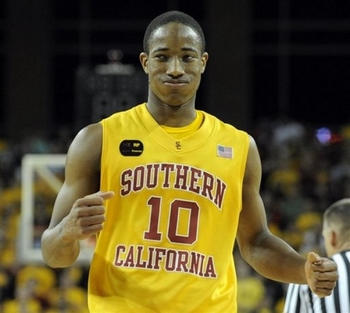
DeMar DeRozan has been getting better and better over the past few weeks, and definitely came up with a strong performance in this particular game we took in against Arizona State, with 16 points and 10 rebounds (6 of them offensive).
USC is doing a good job of playing to DeRozans strengths lately, and trying to minimize his weaknesses. They like to bring him off cuts and curls, putting him in a situation where he can dribble the ball once or twice and then elevate for a soft finish. His production is up from the last time we profiled him, and hes making a good amount of his two-point shots (56%), while getting to the line at a decent rate. He looks smarter and more aggressive these days for sure, doing a much better job of utilizing his athleticism, which is obviously his biggest strengths. This showed up primarily in his work on the offensive glass, an area that hes been quite effective in thanks to his size, length and leaping ability.
Defensively, he looked pretty intense, doing a good job trying to shadow his man, even if his fundamentals obviously arent great and he tends to show poor awareness from time to time. He still has a ways to go in terms of learning how to take advantage of his physical attributes on this end of the floor.
DeRozan knocked down a number of mid-range jumpers in this game, something that hes been doing fairly often from the film we took in after the game. His stroke looks very nice, with range out to about 18 feet, particularly when he has a moment to set his feet and get his shot off.
Still a very limited ball-handler, DeRozans offensive limitations are pretty significant if trying to project him immediately to the NBA. He struggles to change directions with the ball and possesses very little explosion off his first step, making him almost completely unable to create his own shot. If forced to dribble the ball more than once or twice he is liable to get stripped or look out of control, although hes doing a good job of not putting himself in situations where he is liable to turn the ball over. He is averaging twice as many turnovers as assists, which ranks him last amongst all top shooting guard prospects
The fact that DeRozans jumper doesnt have much range (hes shooting just 2/22 from 3-point range), he cannot play pick and roll, is not a great passer, possesses just an average basketball IQ, and his understanding of how to operate in the half-court is limited, makes him a clear-cut project for the NBA. The main question is, how much he is going to improve over the next few years? The answer to that largely depends on his work ethic and character, which draws strong reviews from those around him. Some teams are not that opposed to taking a player who obviously possesses great upside, especially once you get outside of the lottery. One GM we spoke to compared him to Gerald Wallace as a freshman, saying how he was even more limited a player at the same point in his career.
DeRozan obviously looks like he needs another year in college to develop his all-around game in a nurturing setting, but well have to wait and see what kind of rush hes in and whether hes content just making the NBA (hes likely a first round pick), as opposed to rolling in on the red carpet.
USC is doing a good job of playing to DeRozans strengths lately, and trying to minimize his weaknesses. They like to bring him off cuts and curls, putting him in a situation where he can dribble the ball once or twice and then elevate for a soft finish. His production is up from the last time we profiled him, and hes making a good amount of his two-point shots (56%), while getting to the line at a decent rate. He looks smarter and more aggressive these days for sure, doing a much better job of utilizing his athleticism, which is obviously his biggest strengths. This showed up primarily in his work on the offensive glass, an area that hes been quite effective in thanks to his size, length and leaping ability.
Defensively, he looked pretty intense, doing a good job trying to shadow his man, even if his fundamentals obviously arent great and he tends to show poor awareness from time to time. He still has a ways to go in terms of learning how to take advantage of his physical attributes on this end of the floor.
DeRozan knocked down a number of mid-range jumpers in this game, something that hes been doing fairly often from the film we took in after the game. His stroke looks very nice, with range out to about 18 feet, particularly when he has a moment to set his feet and get his shot off.
Still a very limited ball-handler, DeRozans offensive limitations are pretty significant if trying to project him immediately to the NBA. He struggles to change directions with the ball and possesses very little explosion off his first step, making him almost completely unable to create his own shot. If forced to dribble the ball more than once or twice he is liable to get stripped or look out of control, although hes doing a good job of not putting himself in situations where he is liable to turn the ball over. He is averaging twice as many turnovers as assists, which ranks him last amongst all top shooting guard prospects
The fact that DeRozans jumper doesnt have much range (hes shooting just 2/22 from 3-point range), he cannot play pick and roll, is not a great passer, possesses just an average basketball IQ, and his understanding of how to operate in the half-court is limited, makes him a clear-cut project for the NBA. The main question is, how much he is going to improve over the next few years? The answer to that largely depends on his work ethic and character, which draws strong reviews from those around him. Some teams are not that opposed to taking a player who obviously possesses great upside, especially once you get outside of the lottery. One GM we spoke to compared him to Gerald Wallace as a freshman, saying how he was even more limited a player at the same point in his career.
DeRozan obviously looks like he needs another year in college to develop his all-around game in a nurturing setting, but well have to wait and see what kind of rush hes in and whether hes content just making the NBA (hes likely a first round pick), as opposed to rolling in on the red carpet.
Darren Collison, 6-1, Senior, Point Guard, UCLA
14.8 points,4.8 assists, 2.1 turnovers, 1.7 steals, 54% FG, 43% 3P, 93% FT
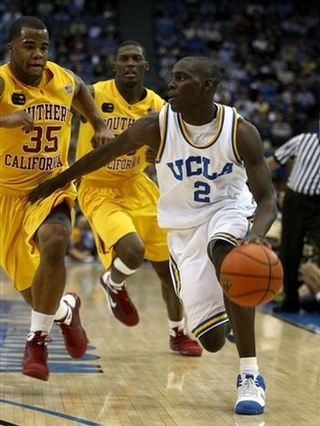
Criticized by some for his decision to return to UCLA last spring, despite seemingly having little to prove at the collegiate level, Darren Collison has made some subtle but important improvements that should solidify his status in the minds of scouts as a sure-fire NBA rotation player.
Collison is scoring better and more efficiently this season, particularly inside the arc, where his 2-point percentages have skyrocketed from 46% to 59.5%, which puts him amongst the top point guards in the country in that category. He continues to shoot the ball from beyond the arc at a nice rate--not quite the outrageous 52.5% from last season--but a still very impressive 43%. Collison doesnt take many bad shots, but its definitely worthwhile to note that hes hitting a superb percentage with his off the dribble attempts, just a hair under 50% on a decent sample size. His release looks slightly quicker this season and the fact that defenders cannot go underneath screens when guarding him bodes well for his ability to translate his perimeter shooting ability to the NBA. The fact that he shoots 93% from the free throw line is a pretty good sign as well.
Forced to handle the ball a bit more than he did last season, Collisons assists are back up while his assist to turnover ratio is at an all-time high. He doesnt have the jet-quicks or fancy improvisation skills to be able (or maybe even willing) to be an incredibly creative force slashing to the basket and creating scoring opportunities for himself and others. Collison is a half-court point guard who needs to have strong slasher/scorers around him, as he may struggle to get to the rim quite as effectively at the NBA level. For what teams usually look for in a backup point guard, though, he may be ideal, as he doesnt turn the ball over, hits his shots at a solid clip, and is perfectly capable of running an offense.
On top of that, Collison is a very strong defender, being very fundamentally sound and extremely pesky getting in the passing lanes. He does a great job staying in front of his man and always put a good effort in, even if his lack of size and strength may hinder him a bit, particularly fighting through screens.
When its all said and done, Collison looks likely to carve himself out a niche in the league, similar to the way Chris Duhon and more recently Mario Chalmers has. Hes not going to blow anyone away with his upside, and he might not ever prove to be ideal starting material, but there is obviously a place in the league for a player with his skill-set, basketball IQ, experience and all-around intangibles. If he lands on the right team, in the right system, alongside the right players, he may even thrive.
Collison is scoring better and more efficiently this season, particularly inside the arc, where his 2-point percentages have skyrocketed from 46% to 59.5%, which puts him amongst the top point guards in the country in that category. He continues to shoot the ball from beyond the arc at a nice rate--not quite the outrageous 52.5% from last season--but a still very impressive 43%. Collison doesnt take many bad shots, but its definitely worthwhile to note that hes hitting a superb percentage with his off the dribble attempts, just a hair under 50% on a decent sample size. His release looks slightly quicker this season and the fact that defenders cannot go underneath screens when guarding him bodes well for his ability to translate his perimeter shooting ability to the NBA. The fact that he shoots 93% from the free throw line is a pretty good sign as well.
Forced to handle the ball a bit more than he did last season, Collisons assists are back up while his assist to turnover ratio is at an all-time high. He doesnt have the jet-quicks or fancy improvisation skills to be able (or maybe even willing) to be an incredibly creative force slashing to the basket and creating scoring opportunities for himself and others. Collison is a half-court point guard who needs to have strong slasher/scorers around him, as he may struggle to get to the rim quite as effectively at the NBA level. For what teams usually look for in a backup point guard, though, he may be ideal, as he doesnt turn the ball over, hits his shots at a solid clip, and is perfectly capable of running an offense.
On top of that, Collison is a very strong defender, being very fundamentally sound and extremely pesky getting in the passing lanes. He does a great job staying in front of his man and always put a good effort in, even if his lack of size and strength may hinder him a bit, particularly fighting through screens.
When its all said and done, Collison looks likely to carve himself out a niche in the league, similar to the way Chris Duhon and more recently Mario Chalmers has. Hes not going to blow anyone away with his upside, and he might not ever prove to be ideal starting material, but there is obviously a place in the league for a player with his skill-set, basketball IQ, experience and all-around intangibles. If he lands on the right team, in the right system, alongside the right players, he may even thrive.
Jeff Pendergraph, 6-9, Senior, PF/C, Arizona State
13.7 points, 8 rebounds, 1.1 assists,1 turnover, 67% FG, 77% FT
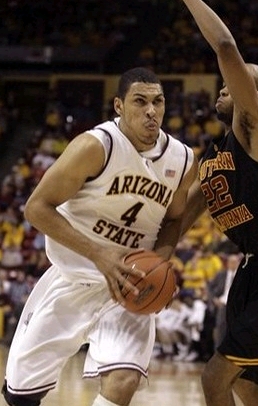
Solid, yet unspectacular, Jeff Pendergraph showed some nice things in the two games we saw him play, solidifying his status as a potential role player for the next level. Hes having a pretty nice season thus far, upping his scoring and rebounding rates from last year and currently ranking #1 amongst all prospects in points per possession. Hes one of the most efficient players in college basketball, shooting 67% from the field and 79% from the free throw line, which speaks to the role he plays for ASU and the fact that he understands his limitations.
Pendergraph is a meat and potatoes type player, mostly living off scraps offensively. The overwhelming majority of his points come off the ball--cuts, offensive rebounds, pick and rolls, and in transition. Hes smart, has terrific hands, and finishes pretty well around the basketwhich makes him a reliable target inside. Arizona State is one of the slowest-paced and most offensively efficient teams in college basketball, and having a passer of James Hardens caliber on the floor obviously doesnt hurt.
Pendergraph is fairly mechanical trying to create his own shot with his back to the basket, although he can find some success doing so at the collegiate level. He rarely if ever attempts to do anything outside the paint, although from the small sample size of clips we saw it appears that developing a solid 15-17 foot mid-range jumper is not out of the question based on the mechanics he shows. Putting the ball on the floor is currently not in his repertoire. Based on his combination of size, athleticism and limited skill-set, Pendergraph does not project to be anything more than a fourth or fifth option at best when hes on the floor. Pendergraph is a solid passer and almost never turns the ball over, which is a good combination for a future role-player.
Defensively, Pendergraph is very solid, showing extremely active feet in Arizona States zone. Hes not particularly tall, long or bulky, but his effort level, smarts and fundamentals allow him to be effective. He has nice timing and will block the occasional shot, although this probably isnt something that is expected to translate that effectively considering his average physical attributes. Hes a good, but not great rebounder on top of that.
In terms of intangibles, Pendergraph is pretty much the entire package, as hes a smart, well-spoken, hard working player on and off the court who graduated in three and a half years and is very well respected by his teammates. Hes a little bit young for his class, though, not turning 22 until the end of April, which means he might not be a finished product just yet.
At the end of the day, Pendergraph is unlikely to blow anyone away with his upside, but might be able to find his niche in the NBA regardless and develop into a solid role player. Beauty is in the eye of the beholder here, and if he gets with the right team its not out of the question that he sticks around for a while. Otherwise, hell have a nice career overseas and will probably make some old-school coach very happy.
Pendergraph is a meat and potatoes type player, mostly living off scraps offensively. The overwhelming majority of his points come off the ball--cuts, offensive rebounds, pick and rolls, and in transition. Hes smart, has terrific hands, and finishes pretty well around the basketwhich makes him a reliable target inside. Arizona State is one of the slowest-paced and most offensively efficient teams in college basketball, and having a passer of James Hardens caliber on the floor obviously doesnt hurt.
Pendergraph is fairly mechanical trying to create his own shot with his back to the basket, although he can find some success doing so at the collegiate level. He rarely if ever attempts to do anything outside the paint, although from the small sample size of clips we saw it appears that developing a solid 15-17 foot mid-range jumper is not out of the question based on the mechanics he shows. Putting the ball on the floor is currently not in his repertoire. Based on his combination of size, athleticism and limited skill-set, Pendergraph does not project to be anything more than a fourth or fifth option at best when hes on the floor. Pendergraph is a solid passer and almost never turns the ball over, which is a good combination for a future role-player.
Defensively, Pendergraph is very solid, showing extremely active feet in Arizona States zone. Hes not particularly tall, long or bulky, but his effort level, smarts and fundamentals allow him to be effective. He has nice timing and will block the occasional shot, although this probably isnt something that is expected to translate that effectively considering his average physical attributes. Hes a good, but not great rebounder on top of that.
In terms of intangibles, Pendergraph is pretty much the entire package, as hes a smart, well-spoken, hard working player on and off the court who graduated in three and a half years and is very well respected by his teammates. Hes a little bit young for his class, though, not turning 22 until the end of April, which means he might not be a finished product just yet.
At the end of the day, Pendergraph is unlikely to blow anyone away with his upside, but might be able to find his niche in the NBA regardless and develop into a solid role player. Beauty is in the eye of the beholder here, and if he gets with the right team its not out of the question that he sticks around for a while. Otherwise, hell have a nice career overseas and will probably make some old-school coach very happy.
Alfred Aboya, 6-9, Senior, PF/C, UCLA
9.6 point, 5.6 rebounds, .9 steals, 59% FG, 67% FT, 26 minutes
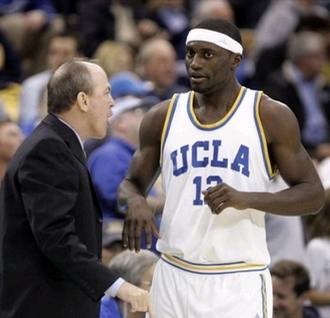
Deserving of a quick mention for the improvement hes shown over the past few months, Alfred Aboya has been playing terrific basketball for UCLA as of late, and if anything is working himself into making some decent cash in Europe if things dont work out with the NBA. Aboya has gone from being a complete non-factor offensively to showing some surprising sparks of scoring ability from time to time, improving his FG% and FT% substantially, while cutting down on his once sky-high personal foul and turnover rates.
Still a fairly limited player offensively, Aboya has proven to be a solid finisher around the basket and a surprisingly decent mid-range jump-shooter. He runs the floor well, is fairly athletic, and gets to the free throw line at a decent rate. He cannot put the ball on the floor or create his own shot with his back to the basket, but seems to understand that.
Defensively, Aboya isnt much of a shot-blocker, but hes pretty active and does a good job hedging screens. He is a very average rebounder, though, which basically nullifies any chance he might have of making the NBA considering his likely role, along with his average size (6-8) and the fact that hes already 24 years old. We thought many of the same things about his teammate Luc Richard Mbah a Moute, though, and that hasnt seemed to hurt him at all in the NBA.
Still a fairly limited player offensively, Aboya has proven to be a solid finisher around the basket and a surprisingly decent mid-range jump-shooter. He runs the floor well, is fairly athletic, and gets to the free throw line at a decent rate. He cannot put the ball on the floor or create his own shot with his back to the basket, but seems to understand that.
Defensively, Aboya isnt much of a shot-blocker, but hes pretty active and does a good job hedging screens. He is a very average rebounder, though, which basically nullifies any chance he might have of making the NBA considering his likely role, along with his average size (6-8) and the fact that hes already 24 years old. We thought many of the same things about his teammate Luc Richard Mbah a Moute, though, and that hasnt seemed to hurt him at all in the NBA.



































Comments